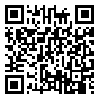BibTeX | RIS | EndNote | Medlars | ProCite | Reference Manager | RefWorks
Send citation to:
URL: http://tumj.tums.ac.ir/article-1-195-en.html

 , Nafissi N
, Nafissi N 
 , Sirati F
, Sirati F 
 , Fallah MS
, Fallah MS 
 , Salehi R
, Salehi R 
 , Harriry Z
, Harriry Z 
 , Shahab Movahead Z
, Shahab Movahead Z 
 , Vahidi M
, Vahidi M 
 , Sharifi Z
, Sharifi Z 
 , Sharafi Farzad M
, Sharafi Farzad M 
 , Zeinali S *
, Zeinali S * 

Normal
0
false
false
false
EN-US
X-NONE
AR-SA
MicrosoftInternetExplorer4
Background: Breast
cancer is the most common form of hereditary cancer worldwide and is an
important cause of morbidity and mortality. Approximately 5-10% of breast
and ovarian cancers are
due to the highly penetrating germline mutations in cancer predisposing genes. Two genes, BRCA1 and BRCA2, account for
at least half of these cases. The demand for BRCA1 and BRCA2 mutation screening is rapidly
increasing as their identification will affect the medical management of people
at increased risk for the disease. Therefore, the aim of this study was to
investigate BRCA1/2 mutations in 100 high risk Iranian families.
Methods: One hundred families who met the
minimal risk factors for breast/ovarian cancer were screened among
the families referred to Kawsar Human Genetics Research
Center for the diseases in 2009-2011. The entire coding sequences and each
intron/exon boundaries of BRCA1/2 genes were screened for by direct
sequencing and MLPA in both patients and the controls.
Results: In the present study, we could detect
the following novel mutations:
p.Gly1140Ser, p.Ile26Val,
p.Leu1418X, p.Glu23Gln,
p.Leu3X, p.Asn1403His,
p.Asn1403Asp, p.Lys581X,
p.Pro938Arg, p.Thr77Arg,
p.Leu6Val, p.Arg7Cys,
p.Leu15Ile, p.Ser177Thr,
IVS7+83(-TT), IVS8 -70(-CATT),
IVS2+9(G>C), IVS1-20(G>A),
IVS1-8(A>G), p.Met1Ile,
IVS2+24(A>G), IVS5-8 (A>G),
IVS2(35-39)TTcctatGAT,
IVS13+9 G>C in BRCA1
and p.Glu1391Gly, p. Val1852Ile,
IVS6-70(T>G), 1994-1995
(InsA) in BRCA2.
Conclusion: Ten mutations seemed to be pathogenic and the disease-causing
mutations were seen in 16% of the families. In addition, from the
total number of substitutions and reassortments (42), 80% related to BRCA1 and 20% to mutations in BRCA2 genes.
| Rights and permissions | |
 |
This work is licensed under a Creative Commons Attribution-NonCommercial 4.0 International License. |



